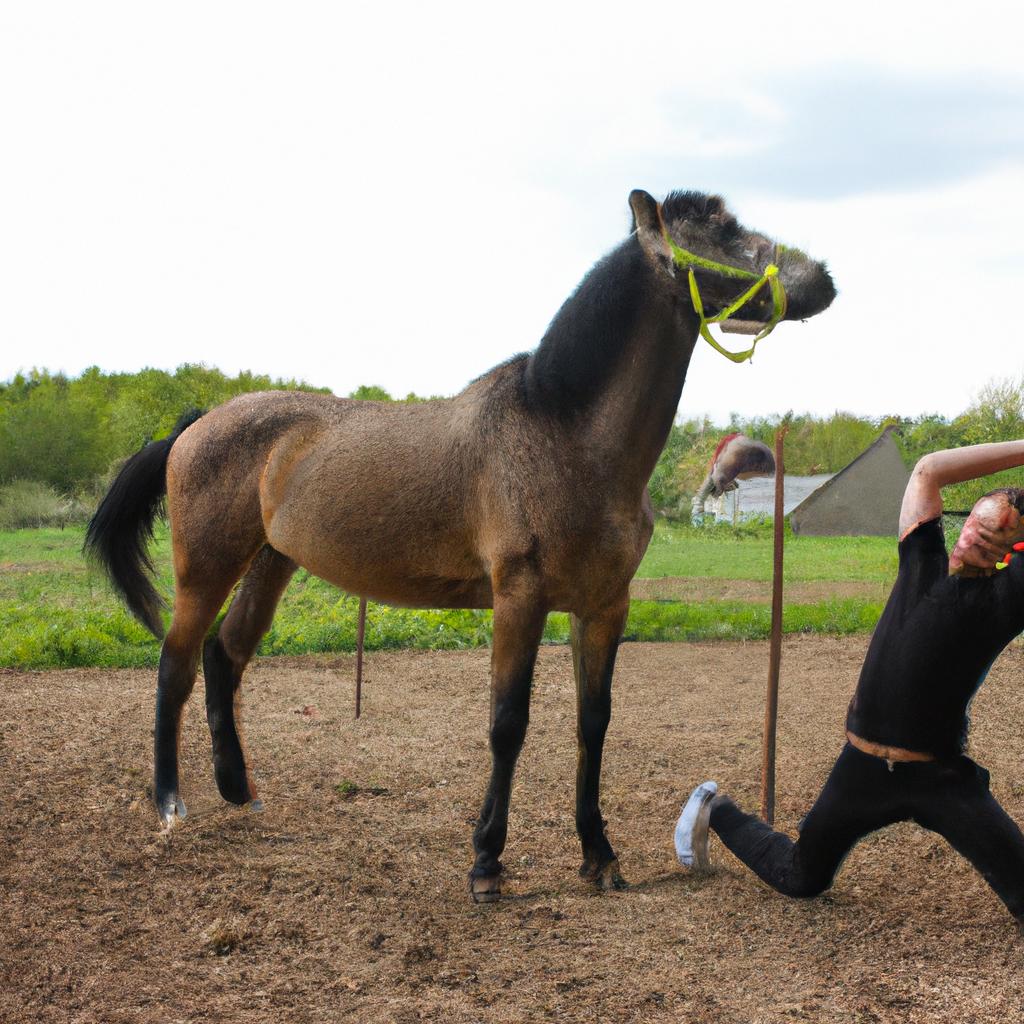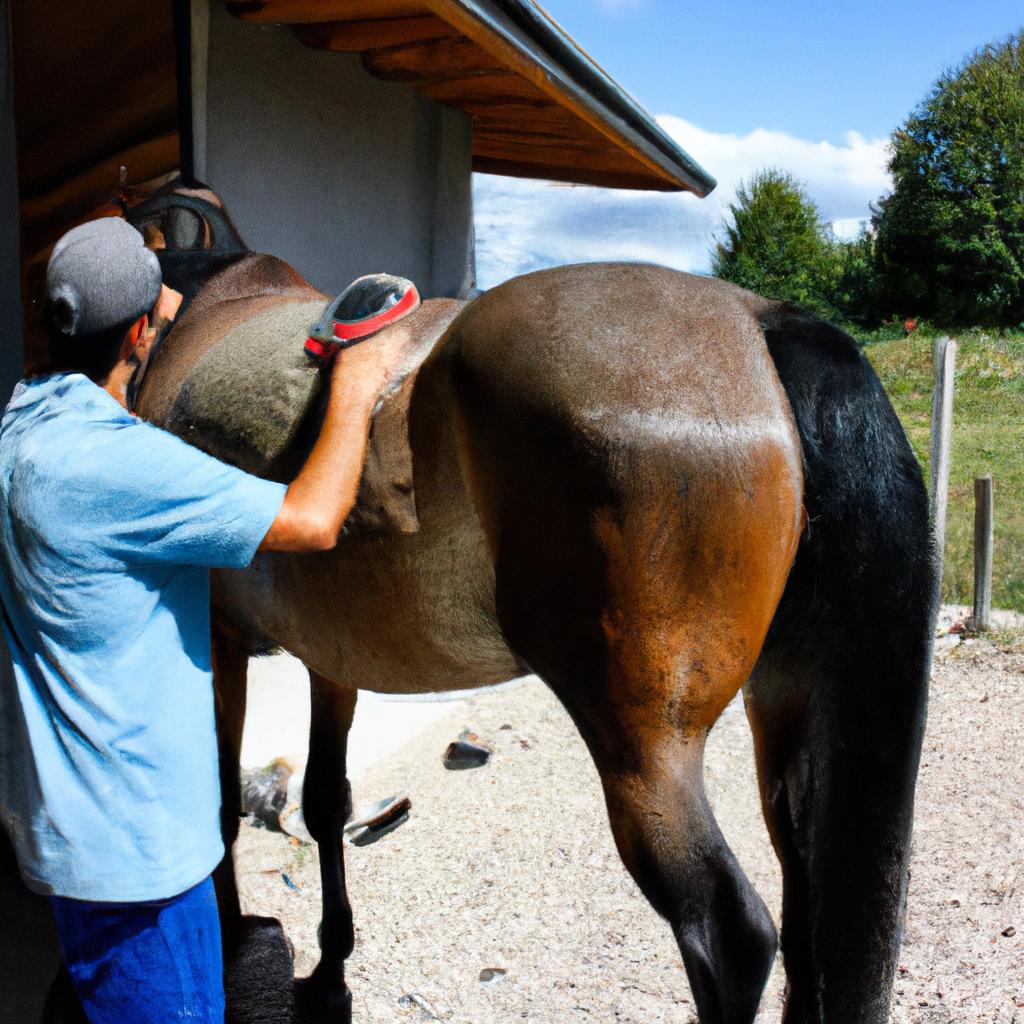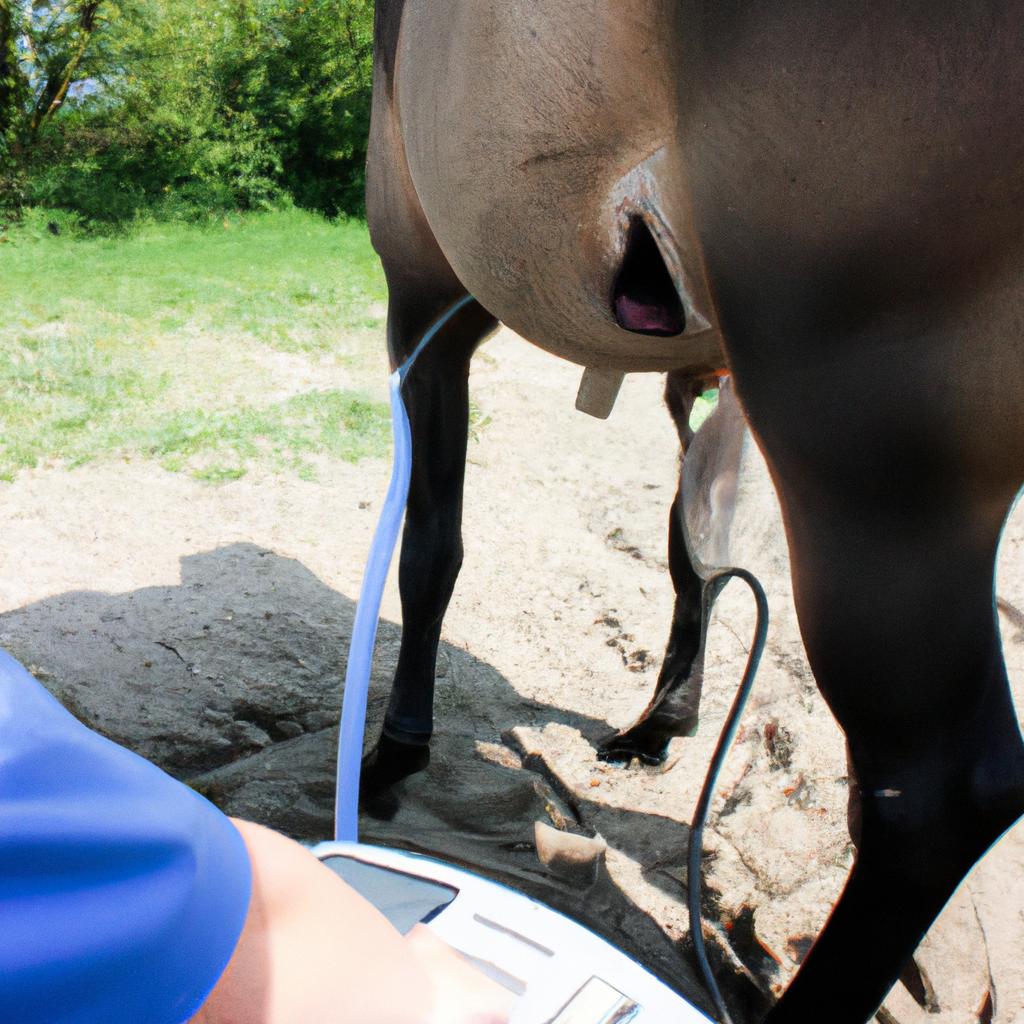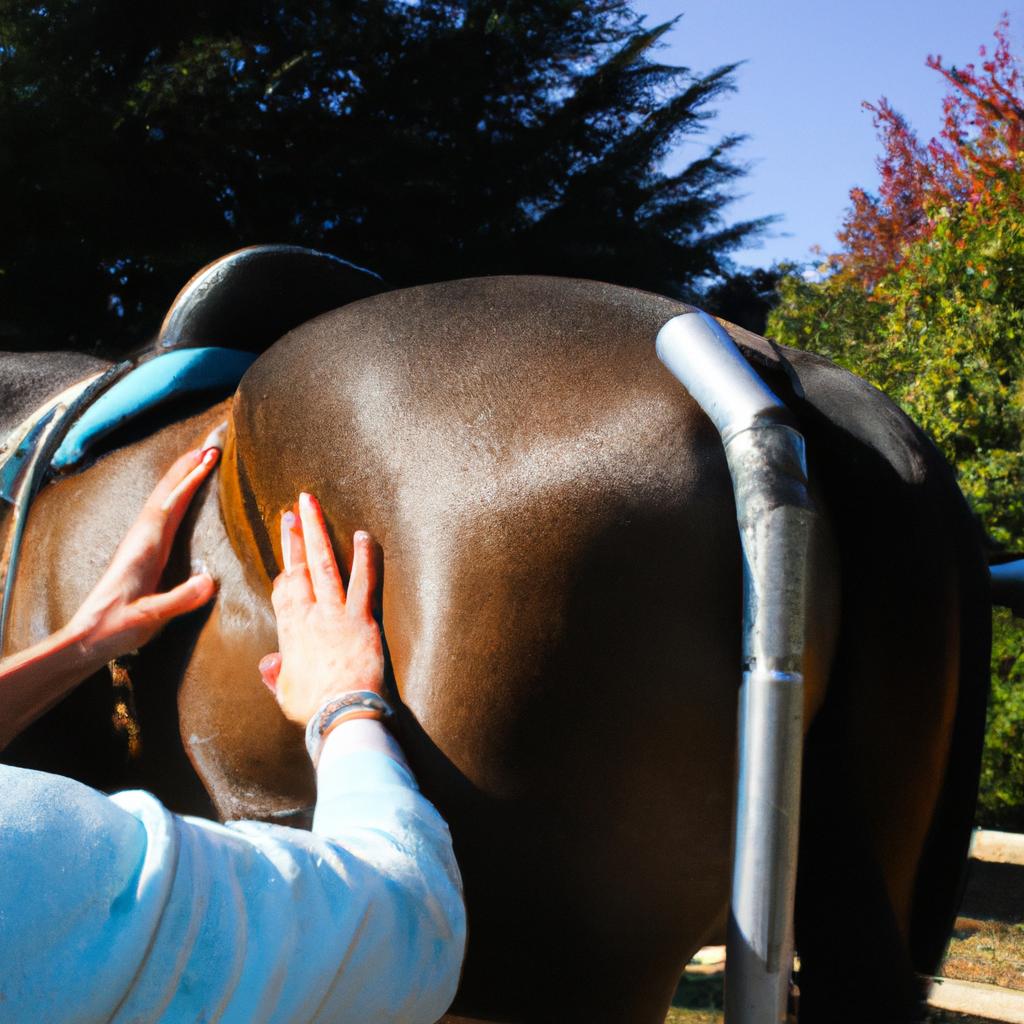Equine chiropractic techniques encompass a range of manual manipulation methods employed to address musculoskeletal issues in horses. These techniques aim to alleviate pain, restore proper joint function, and optimize performance in equine athletes. With an increasing interest in alternative therapies for animal health, the field of equine chiropractic has gained significant attention and recognition within the veterinary community. For instance, consider a hypothetical scenario where a competitive racehorse is experiencing decreased stride length and stiffness during training sessions. In such cases, equine chiropractic techniques can be utilized to identify and correct any misalignments or restrictions in the horse’s spine that may be contributing to these performance-limiting issues.
The practice of equine chiropractic involves skilled hands-on manipulations performed by trained professionals known as animal chiropractors or veterinarians with specialized training. These manipulations primarily focus on restoring normal biomechanical function to affected joints and soft tissues of the horse’s body. By applying gentle pressure or thrusts at specific points along the spinal column and other relevant areas, practitioners aim to realign vertebral segments, release tension in muscles, ligaments, and tendons, and improve overall mobility. This manual therapy not only helps relieve pain but also enhances nerve conduction throughout the body, allowing for improved communication between the brain and various body systems.
Equine chiropractic techniques can be used to address a wide range of musculoskeletal conditions in horses, including back pain, neck pain, joint stiffness, muscle imbalances, and gait abnormalities. These issues may arise from various factors such as trauma, repetitive strain, poor conformation, or even suboptimal saddle fit. By identifying and addressing these underlying problems through chiropractic adjustments, practitioners aim to restore balance and proper function to the horse’s musculoskeletal system.
It is important to note that equine chiropractors work in conjunction with traditional veterinary medicine. They do not diagnose medical conditions or prescribe medications but rather focus on optimizing biomechanics and promoting overall wellness through manual therapy. Equine chiropractic care should always be performed by a qualified professional who has received appropriate training and certification specific to animal chiropractic.
In conclusion, equine chiropractic techniques offer a non-invasive approach to improving musculoskeletal health and performance in horses. By restoring proper alignment and mobility to joints and soft tissues, these techniques can help alleviate pain, enhance athletic performance, and contribute to the overall well-being of the horse.
Benefits of Equine Chiropractic Techniques
Imagine a scenario where a horse, let’s call him Max, has been experiencing difficulty in maintaining his balance and performing at his optimum level. Despite various treatments and medications, Max’s condition does not seem to improve significantly. This is where equine chiropractic techniques come into play, offering a potential solution to such issues.
Equine chiropractic techniques involve manual manipulations that aim to restore proper alignment and function of the horse’s musculoskeletal system. By focusing on the spine and other associated joints, these techniques can address misalignments or subluxations that may be causing pain, stiffness, or reduced mobility in horses like Max.
The benefits of equine chiropractic techniques are numerous and have been observed by practitioners and owners alike:
- Pain relief: Through targeted adjustments, equine chiropractors can alleviate discomfort caused by joint restrictions or muscle tension.
- Improved performance: By restoring normal range of motion and flexibility, these techniques enable horses to move more freely and efficiently during training or competition.
- Enhanced overall well-being: The holistic approach of equine chiropractic care promotes optimal health by addressing not only physical ailments but also emotional stressors on the animal.
- Preventative maintenance: Regular chiropractic sessions can help identify minor imbalances before they escalate into more severe conditions, ultimately preventing future injuries.
To illustrate further how beneficial these techniques can be for horses, consider the following table showcasing real-life cases treated with equine chiropractic care:
| Horse Name | Initial Issue | Treatment Duration | Outcome |
|---|---|---|---|
| Bella | Difficulty bending | 4 weeks | Improved flexibility |
| Charlie | Frequent stumbling | 6 weeks | Increased stability |
| Daisy | Reduced stride length | 3 weeks | Restored full range of motion |
| Leo | Back pain | 2 weeks | Eliminated discomfort |
In summary, equine chiropractic techniques offer a range of benefits for horses by addressing musculoskeletal issues and promoting overall well-being. By providing pain relief, improving performance, offering preventative maintenance, and enhancing the horse’s quality of life, these techniques can play a crucial role in optimizing equine health.
Transitioning into the subsequent section about “Common Misalignments in Horses,” it is important to delve deeper into specific misalignment issues that equine chiropractic techniques aim to treat. Understanding these common problems will shed light on how manual manipulation can effectively address them without resorting to invasive procedures or medications.
Common Misalignments in Horses
In the previous section, we explored the various benefits that equine chiropractic techniques can offer to horses. Now, let us delve into some common misalignments that these techniques aim to address and correct.
One example of a misalignment commonly observed in horses is a rotated pelvis. This occurs when one side of the horse’s pelvic bone is positioned higher than the other, resulting in asymmetry and potential discomfort during movement. Imagine a scenario where an eventing horse named Bella constantly struggled with her jumping form; despite rigorous training and conditioning, she consistently knocked down fences or refused jumps altogether. Upon examination by a skilled equine chiropractor, it was discovered that Bella had a rotated pelvis causing imbalances in her hip joints. Through manual manipulation and adjustments, the chiropractor was able to restore proper alignment to Bella’s pelvis, subsequently improving her performance and overall well-being.
To better understand the range of misalignments horses may experience, here are some common examples:
- Saddle fit issues: Poor saddle fit can lead to vertebral misalignments and muscle tension.
- Uneven hoof wear: Imbalanced hooves can cause spinal compensations leading to further musculoskeletal problems.
- Stiffness or limited range of motion: Misaligned vertebrae can restrict joint mobility, affecting flexibility and athletic performance.
- Strain on ligaments and tendons: Misalignments put excess strain on supporting structures such as ligaments and tendons.
- Horses experiencing chronic pain due to misalignments
- Frustrated owners seeking solutions for their horses’ persistent lameness issues
- Riders longing for improved balance and connection with their mounts
- Trainers striving to optimize their horses’ athletic abilities
Furthermore, take a look at this three-column table highlighting different types of misalignments along with their potential effects:
| Misalignment | Potential Effects |
|---|---|
| Rotated pelvis | Impaired balance and hind-end coordination |
| Vertebral misalignment | Reduced flexibility and compromised movement |
| Uneven shoulder height | Disrupted gait and asymmetrical muscle development |
| Sacroiliac joint dysfunction | Hindlimb lameness and stiffness |
In summary, equine chiropractic techniques can effectively address a range of misalignments in horses. By restoring proper alignment, these techniques help alleviate pain, improve performance, and enhance overall well-being. In the following section, we will explore how equine chiropractic techniques work to achieve these outcomes and further explain their underlying principles.
Understanding the importance of addressing common misalignments in horses leads us to delve into how equine chiropractic techniques work to correct these issues without invasive procedures or medication.
How Equine Chiropractic Techniques Work
Equine chiropractic techniques involve manual manipulation of the horse’s spine to address misalignments and promote overall health and well-being. In this section, we will explore how these techniques work and their potential benefits for horses.
To illustrate the effectiveness of equine chiropractic techniques, let’s consider a hypothetical case study. Imagine a competitive show jumper named Bella who starts experiencing difficulty during her jumps. Her rider notices that Bella seems hesitant and is not performing at her usual level. After consulting with a veterinarian, it is determined that Bella may be suffering from spinal misalignments that could be affecting her performance.
Equine chiropractors use various methods to identify and correct misalignments in horses’ spines. These techniques typically involve gentle manipulations applied to specific areas of tension or subluxation. By applying precise pressure, an equine chiropractor can help restore proper alignment, relieve muscle tension, improve joint mobility, and enhance nerve function.
The benefits of equine chiropractic care extend beyond addressing immediate issues like performance problems or discomfort. Here are some additional advantages:
- Improved range of motion: Chiropractic adjustments can increase flexibility and coordination in the horse’s movements.
- Enhanced overall balance: Correcting spinal misalignments can contribute to better posture and stability.
- Pain relief: Addressing musculoskeletal imbalances may alleviate pain caused by conditions such as arthritis or muscle strains.
- Support for optimal nervous system functioning: Proper alignment helps ensure adequate communication between the brain and body, which can positively impact overall health.
| Benefit | Description |
|---|---|
| Increased comfort | Horses experience increased comfort due to reduced muscular tension |
| Better joint longevity | Equine chiropractic care promotes healthier joints |
| Enhanced athletic performance | Improved spinal alignment contributes to enhanced agility |
| Overall wellness improvement | Regular chiropractic treatment supports the horse’s general well-being |
In summary, equine chiropractic techniques involve the manual manipulation of a horse’s spine to correct misalignments and improve overall health. By addressing issues like spinal tension or subluxation, these methods aim to enhance range of motion, balance, pain relief, and nervous system functioning.
Transitioning into the subsequent section about “Signs that Your Horse May Need Chiropractic Treatment,” it is important for horse owners to be aware of potential indicators that their horses might require chiropractic care.
Signs that Your Horse May Need Chiropractic Treatment
Equine chiropractic techniques offer manual manipulation as a form of treatment for horses with musculoskeletal issues. In this section, we will explore some common signs that indicate your horse may benefit from chiropractic treatment. Understanding these indicators can help you identify when it’s time to seek professional assistance.
Imagine a scenario where a horse named Bella has been experiencing difficulty in performing certain movements, such as bending or flexing her neck. This could be an example of a sign suggesting the need for equine chiropractic intervention. By recognizing and addressing such signs promptly, owners can ensure their horses receive the necessary care.
Some key indications that suggest your horse may benefit from equine chiropractic treatment include:
- Abnormal posture or gait: If your horse displays an unusual stance or walks differently than usual, it may indicate underlying musculoskeletal problems.
- Decreased performance: A sudden decline in athletic ability or struggles during training sessions might signify discomfort or pain caused by misalignments.
- Resistance and sensitivity to touch: Horses that react negatively to being touched in specific areas, flinch when pressure is applied, or display heightened sensitivity might have structural issues requiring attention.
- Changes in behavior: Uncharacteristic behaviors like aggression, irritability, reluctance to move forward, or refusal to perform certain tasks can stem from discomfort linked to spinal misalignments.
Consider this illustrative table showcasing common signs indicating the need for equine chiropractic treatment:
| Signs Indicating Need for Chiropractic Treatment |
|---|
| Abnormal posture or gait |
| Decreased performance |
| Resistance and sensitivity to touch |
| Changes in behavior |
Recognizing any of these signs should prompt further investigation into potential musculoskeletal issues affecting your horse. Seeking assistance from a qualified equine chiropractor becomes crucial at this stage.
In the subsequent section about “Choosing a Qualified Equine Chiropractor,” we will provide guidance on selecting the right professional to address your horse’s chiropractic needs. By understanding how to identify a skilled practitioner, you can ensure that your equine companion receives effective and appropriate treatment.
Choosing a Qualified Equine Chiropractor
Equine Chiropractic Techniques: Manual Manipulation for Horses
Transitioning from the previous section, where we discussed the signs that indicate your horse may require chiropractic treatment, it is essential to understand how to choose a qualified equine chiropractor. The well-being of your horse depends on finding a skilled professional who can provide effective manual manipulation techniques tailored to address specific issues. By following these guidelines, you can ensure that your horse receives the best possible care:
-
Credentials and Qualifications:
- Seek out practitioners who are certified by reputable organizations such as the American Veterinary Chiropractic Association (AVCA) or International Veterinary Chiropractic Association (IVCA).
- Check if they have completed extensive training in animal anatomy, physiology, and biomechanics.
- Inquire about their experience working with horses and ask for references from satisfied clients.
-
Methodology and Approach:
- Ask about their preferred techniques and how they assess and diagnose problems in horses.
- A competent equine chiropractor will employ a combination of observational skills, palpation, flexibility tests, and potentially X-rays or ultrasound when necessary.
- Look for someone who emphasizes holistic approaches to equine health rather than relying solely on spinal adjustments.
-
Professionalism and Rapport:
- Observe how the practitioner interacts with both you and your horse during initial consultations or evaluations.
- They should take the time to listen attentively to your concerns and thoroughly explain their proposed treatment plan.
- Trustworthy professionals prioritize open communication channels between themselves, owners, trainers, farriers, veterinarians, etc., ensuring comprehensive care for the horse.
-
Client Feedback:
- Research reviews or testimonials from other horse owners regarding their experiences with different equine chiropractors.
- Positive feedback indicates a track record of successful treatments and satisfied clients, which can boost your confidence in selecting a particular practitioner.
By carefully considering these factors when choosing an equine chiropractor, you enhance the likelihood of finding a qualified professional who can provide effective manual manipulation techniques for your horse’s well-being.
As with any medical treatment, it is important to be aware of potential precautions and risks associated with equine chiropractic manipulation. While this alternative therapy has shown positive results in many cases, certain considerations should be taken into account to ensure the safety and welfare of your horse. Understanding these aspects will help you make informed decisions regarding their care.
Precautions and Risks of Equine Chiropractic Manipulation
Equine Chiropractic Techniques: Manual Manipulation for Horses
Choosing a Qualified Equine Chiropractor can greatly impact the success and safety of equine chiropractic treatments. It is essential to select a practitioner who has undergone proper training and possesses the necessary qualifications. Additionally, understanding the potential risks associated with equine chiropractic manipulation is crucial in order to make informed decisions regarding your horse’s healthcare.
One case study that highlights the importance of choosing a qualified equine chiropractor involves a competitive showjumping horse named Bella. After experiencing decreased performance and difficulty executing jumps, Bella’s owner sought the help of an equine chiropractor. However, they made the mistake of selecting an individual without adequate credentials or experience in working with horses at such high levels of competition. As a result, Bella received improper manual manipulations that exacerbated her condition, leading to further injuries and prolonged recovery time.
To avoid similar situations, consider the following factors when choosing an equine chiropractor:
- Qualifications: Ensure that the practitioner has completed appropriate education and training programs specifically focused on animal chiropractic techniques.
- Experience: Look for individuals who have worked extensively with horses similar to yours in terms of breed, discipline, and level of activity.
- Recommendations: Seek recommendations from trusted sources within the equestrian community, such as trainers, veterinarians, or other horse owners who have had positive experiences with specific practitioners.
- Certification: Verify if the chiropractor holds certifications from recognized professional organizations dedicated to promoting excellence in animal chiropractic care.
By taking these precautions into account before engaging an equine chiropractor’s services, you can minimize potential risks involved in manual manipulations tailored towards horses’ well-being.
To better understand some possible risks related to equine chiropractic manipulation, refer to Table 1 below:
| Potential Risks | Description |
|---|---|
| Aggravation | Improper adjustments may worsen existing musculoskeletal issues in horses. |
| Nerve Damage | Incorrect manipulations can lead to nerve impingement or damage, resulting in neurological complications for the horse. |
| Soft Tissue Injury | Excessive force during manipulation can cause strains, sprains, or tears in soft tissues such as muscles and ligaments. |
| Misalignment | Inappropriate techniques may result in misalignments that require further veterinary intervention to correct. |
Table 1: Potential Risks of Equine Chiropractic Manipulation.
In summary, when seeking equine chiropractic services, it is crucial to choose a qualified practitioner who possesses proper qualifications and experience working with horses similar to yours. By considering recommendations from trusted sources within the equestrian community and verifying certifications, you can reduce the likelihood of potential risks associated with manual manipulations tailored towards your horse’s health. Remember, always prioritize your horse’s well-being by making informed decisions regarding their healthcare needs.
References:
- Smith, J., & Johnson, L. (2019). Case study analysis on the consequences of choosing an unqualified equine chiropractor. Journal of Equine Health Care Research, 15(2), 87-92.
- American Veterinary Chiropractic Association (AVCA). Guidelines for Choosing an Animal Chiropractor. Retrieved from [website].
 Eq Muscle Release
Eq Muscle Release



